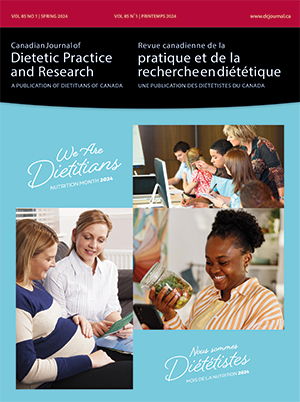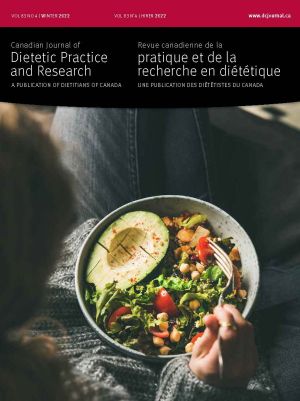Volume 63 • Number 4 • December 2002
Chair’s Message
Research
This study compared the effectiveness of physician advice versus dietitian advice for a fat-reduced diet, and of dietitian advice for a fat-reduced diet versus a soluble fibre-enhanced diet in patients with moderate dyslipidemia. A total of 111 men and women took part in this 26-week, three-group, randomized, clinical trial. The physician advice fat-reduced diet group (n = 38) and the dietitian advice fat-reduced diet group (n = 35) received dietary advice based on the American Heart Association (AHA) Step II guidelines. The dietitian advice soluble fibre-enhanced diet group (n = 38) consumed one-third cup per day of psylliumcontaining cereal and was advised to increase soluble fibre intake to over 10 grams a day. LDL-C, TC/HDL-C ratio and body weight reductions over six months were –5.3%, –4.6%, and –1.9%, respectively, regardless of whether a physician or a dietitian provided advice, or whether advice was focused on a fat-reduced diet or a soluble fibre-enhanced diet. Both dietitians and physicians can help moderately dyslipidemic patients make clinically meaningful changes in blood lipid levels. Soluble fibre enhancement of the usual diet leads to similar reductions in LDL-C and TC/HDL-C ratio compared to interventions focused on fat reduction.
The purpose of this study was to compare the newly released dietary reference intakes with the 1990 Nova Scotia Nutrition Survey and identify characteristics that influence compatibility with these new recommendations. For each of 17 nutrient recommendations, we calculated the proportion of participants who consumed intakes within the recommended range. We constructed a score reflecting overall compatibility between the new recommendations and the Nova Scotia Nutrition Survey data. Using this score as the dependent variable, we conducted multivariate regression analysis to evaluate the importance of demographic and behavioural factors for compatibility with the dietary reference intakes. Results indicate that compatibility with the dietary reference intakes was poor among Nova Scotians, particularly for magnesium, vitamins C and E, and macronutrients. Compatibility was lower among females than among males, and differed independently by age, body mass index, socioeconomic factors, smoking status, and alcohol consumption. Dietary intervention is needed in Nova Scotia. Reduced fat intake and increased intake of specific vitamins should be promoted. We recommend that nutrition education campaigns coinciding with the introduction of the dietary reference intakes in Nova Scotia target younger people, those of lower socioeconomic background, smokers, and those who are obese.
In the last 30 years, the prevalence of low dietary iron intake has increased, partly because North Americans have been encouraged to choose lower fat foods, including leaner meats. As a result, there has been a decrease in red meat consumption. The objective of this study was to estimate absorbable iron intakes of a representative sample of the Quebec adult population and to compare these results with the new North American recommendations for iron. Dietary intakes were obtained by 24-hour recall and absorbable iron intakes were estimated using Monsen & coworker's model. While 18.9 % and 2.5% of women and men respectively had an iron intake below the estimated average requirement (EAR), 66.2 % and 25.6% had an estimated available iron intake below the recommended level for absorbed iron. Beef consumption had the strongest association with estimated absorbable iron, followed by vegetables. Subjects with a high education level consumed significantly less meat, beef and heme iron than subjects whose education level was low or moderate. These results indicate that there is a need for improving iron intake in the Quebec adult population.
The goals of this practice-based, observational study were to describe the prevalence of low bone mineral density in patients at the Edmonton Cystic Fibrosis Centre, and to determine if body mass index and previous systemic corticosteroid use of over one month's duration were predictors of low bone mineral density. One hundred and thirteen pediatric and adult patients were studied. Bone mineral density of the lumbar spine region was measured using dual-energy X-ray absorptiometry. A total of 42.5% of patients had a bone mineral density Z-score of less than –1 standard deviation. Low bone mineral density was apparent at nine to 12 years of age, and was most evident in the 20- to 34-year-old group. All but one patient under age 20 with a Z-score of less than –2.5 also had a body mass index below the fifth percentile. A low Z-score was also associated with previous systemic corticosteroid use of over one month's duration (relative risk 1.81, p=0.003). We conclude that low bone mineral density is common in cystic fibrosis patients. Low body mass index percentiles may be used to identify children and adolescents at risk of low bone mineral density. These patients may benefit from aggressive nutrition therapy. Systemic corticosteroid use should be assessed carefully, as it is a risk factor for low bone mineral density.
Report
The rotary diversified diet, used in the management of environmental illness, consists of eliminating prohibited foods from the diet and rotating remaining non-prohibited foods and their “food families” within a regular cycle. We assessed the adequacy of nutrient intakes in 22 women prescribed the diet, described the nature of supplement use, and assessed the relationship between adherence and nutrient intake levels. Except for calcium and folacin intakes, mean nutrient intakes met or exceeded recommended levels. No subjects had calcium intakes above the adequate intake for calcium; 72.7% had folate intakes below the estimated average requirement. Intakes of other nutrients, except thiamin and magnesium, were below the estimated average requirement in less than 25% of the sample; 31.8% and 45.5% of subjects, respectively, had thiamin and magnesium intakes at this level. Those who adhered more closely to the rotary diversified diet had higher intakes of vitamin C, vitamin B6, folate, and fibre than did those who followed the diet less closely. Supplements conferred some nutritional benefits; however, supplemental niacin and magnesium intakes exceeded tolerable upper intake levels. Those prescribed the rotary diversified diet require nutrition counselling from dietitians to cope with the complexity and restrictiveness of the diet.
A pilot outpatient group for patients with anorexia nervosa was developed and co-led by a dietitian and a psychologist on a general hospital eating disorders team. The main goal of the short-term nutrition and behaviour change group was weight gain through normalization of eating. The first three groups conducted in the clinic were evaluated by monitoring group members’ weights, collecting pre-treatment and post-treatment scores on the Eating Attitudes Test-26, and comparing earlier and later food records. The mean (+/− standard deviation) patient weight gain per eight-week group cycle was 1.6 (+/− 1.9) kg (p<0.05) and the Eating Attitudes Test-26 score change was −17.1 (+/− 11.5) points (p<0.01). Statistically significant changes were found in consumption of calories (p<0.01), fat (p<0.005), and protein (p<0.02). This treatment approach warrants further refinement and investigation.










